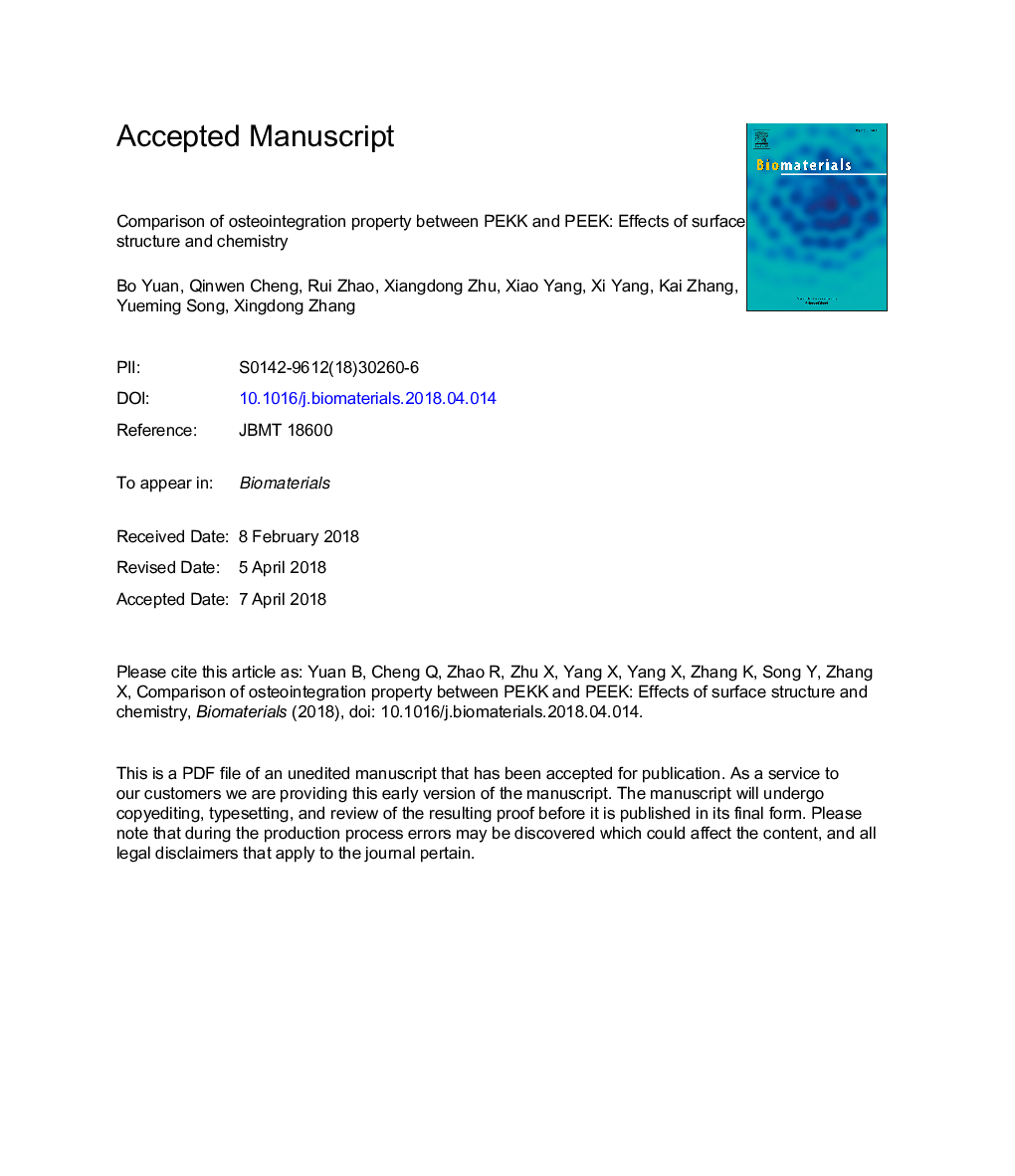| کد مقاله | کد نشریه | سال انتشار | مقاله انگلیسی | نسخه تمام متن |
|---|---|---|---|---|
| 6484510 | 1416097 | 2018 | 39 صفحه PDF | دانلود رایگان |
عنوان انگلیسی مقاله ISI
Comparison of osteointegration property between PEKK and PEEK: Effects of surface structure and chemistry
دانلود مقاله + سفارش ترجمه
دانلود مقاله ISI انگلیسی
رایگان برای ایرانیان
کلمات کلیدی
موضوعات مرتبط
مهندسی و علوم پایه
مهندسی شیمی
بیو مهندسی (مهندسی زیستی)
پیش نمایش صفحه اول مقاله

چکیده انگلیسی
Weak osteointegration affects the long-term stability of polyaryletherketone (PAEK) implants. Surface modification provides a potential solution to improve the osteointegration property of PAEKs. Polyetheretherketone (PEEK) and polyetherketoneketone (PEKK) are two representative PAEK materials, but the latter has more ketone groups and better potential for surface chemical modification than the former. In this work, porous PEKK (PEKK-P) and PEEK (PEEK-P) were fabricated by a porogen leaching method. The samples were treated with 80% sulfuric acid (PEKK-SP and PEEK-SP) and then simulated body fluid (SBF) incubation (PEKK-BSP and PEEK-BSP). More micropores and higher hydrophilic SO3H groups were found on PEKK-SP than PEEK-SP. Likely, more bone-like apatite crystals deposited on PEKK-BSP than PEEK-BSP. To evaluate their osteointegration properties, the samples were implanted in femoral condyle defects (Φ3â¯Ãâ¯4â¯mm3) of rat models, and micro-computed tomography (μ-CT), histology and mechanical analyzes were performed on the retrieved specimens. For control groups, i.e. the dense samples (PEKK-D and PEEK-D), only a handful of bone creeping growth on the implant surface was seen on them. However, with the interconnected macropores, surface micro/nano topography and bone-like apatite, notable bone growth into the inner pores was observed on PEKK-BSP and PEEK-BSP. Furthermore, quantitative analyses confirmed that the newly formed bone in PEKK-BSP was nearly more than doubled than that in PEEK-BSP. The push-out force testing results (PEKK-Dâ¯ââ¯PEEK-Dâ¯<â¯PEKK-Pâ¯ââ¯PEEK-Pâ¯<â¯PEEK-BSPâ¯<â¯PEKK-BSP) suggested that the surface chemical modification (sulfonation treatment followed by SBF incubation) along with build-in porous structure played more important role in enhancing the mechanical stability of both PAEK materials than just the physical structure change. Our results revealed that PEKK with more ketone groups allowed easier sulfonation and better bone-like apatite deposition than PEEK, thus endowing PEKK-BSP with better osteointegration and mechanical stability than PEEK-BSP. Therefore, surface modified PEKK could be potential candidate for spinal and orthopedic applications requiring good osteointegration property.
ناشر
Database: Elsevier - ScienceDirect (ساینس دایرکت)
Journal: Biomaterials - Volume 170, July 2018, Pages 116-126
Journal: Biomaterials - Volume 170, July 2018, Pages 116-126
نویسندگان
Bo Yuan, Qinwen Cheng, Rui Zhao, Xiangdong Zhu, Xiao Yang, Xi Yang, Kai Zhang, Yueming Song, Xingdong Zhang,